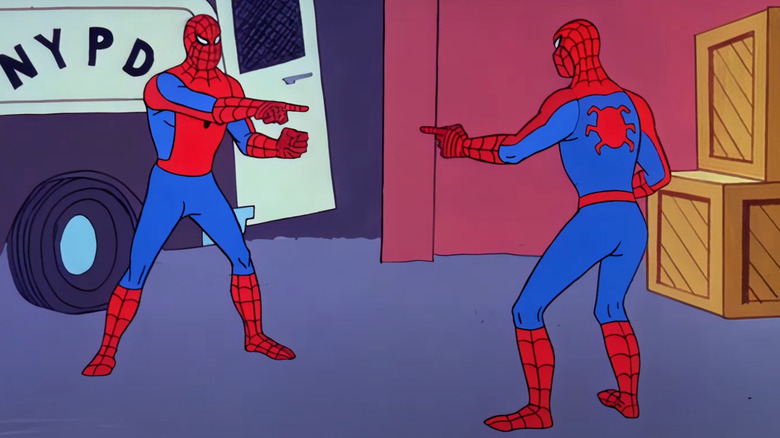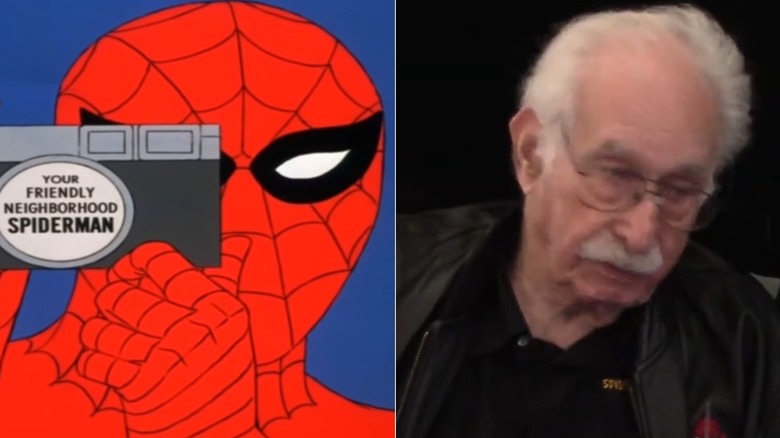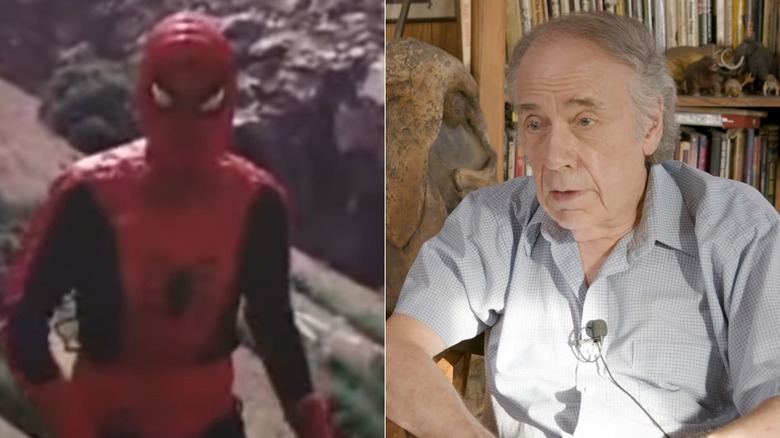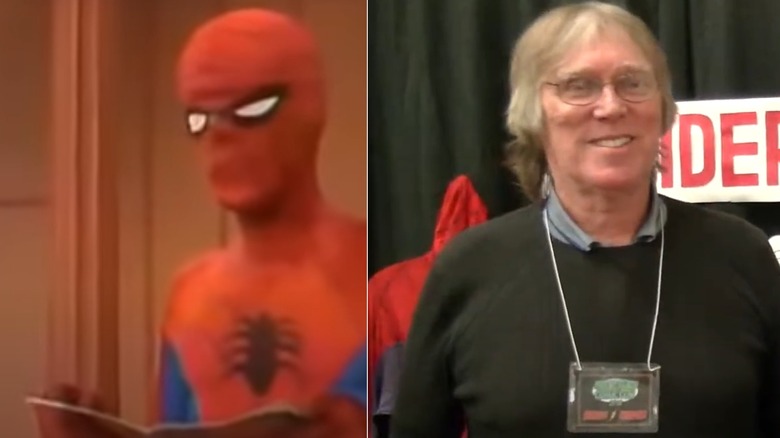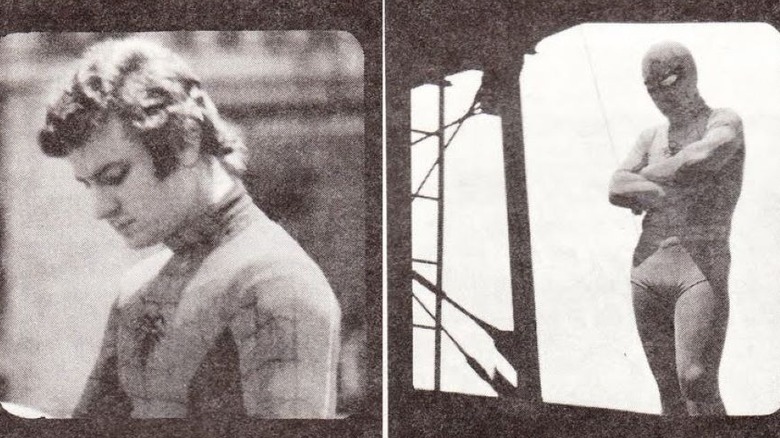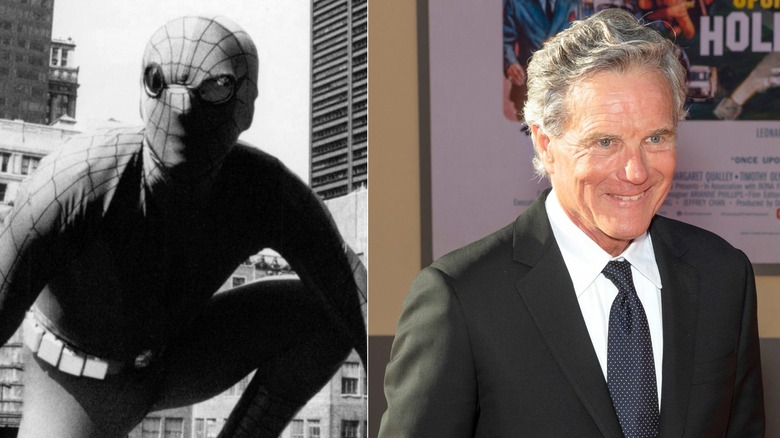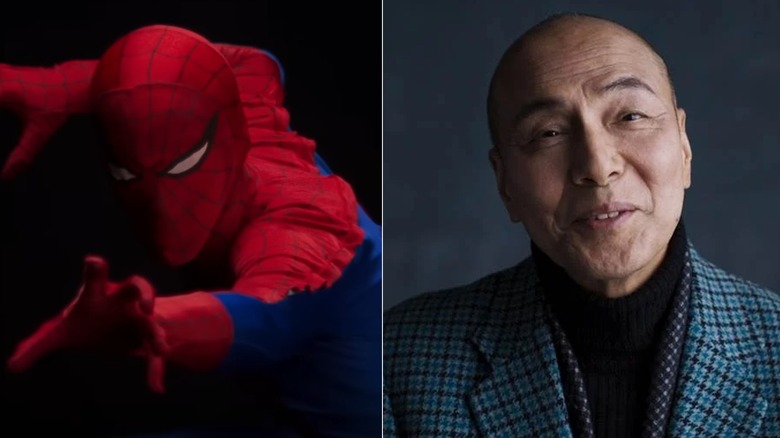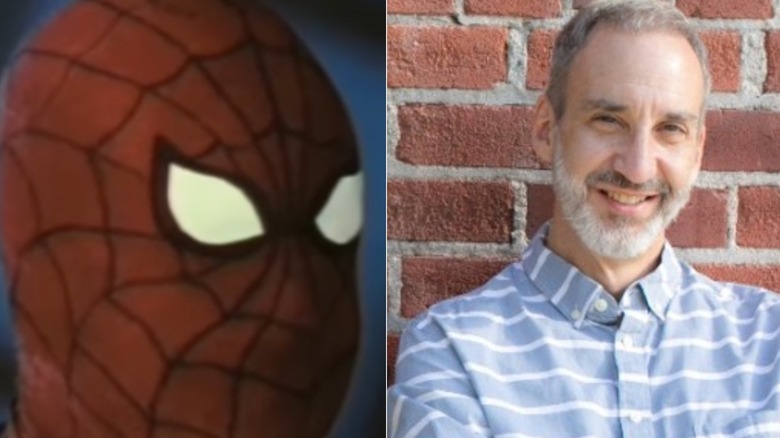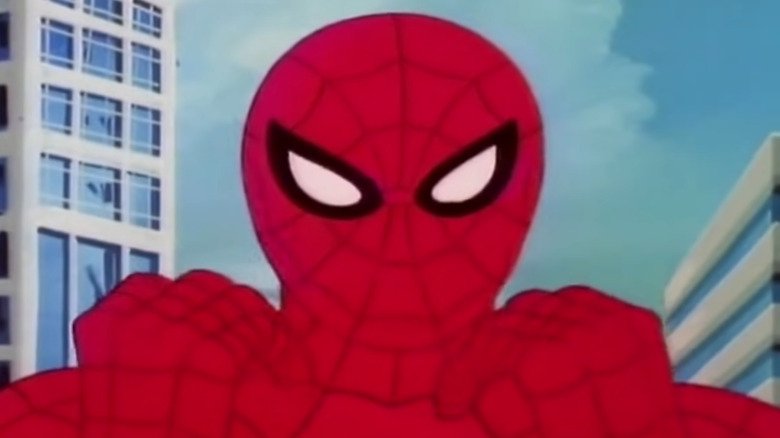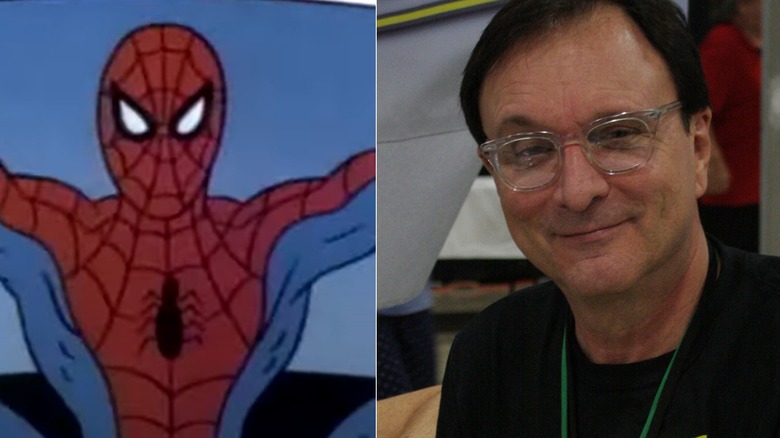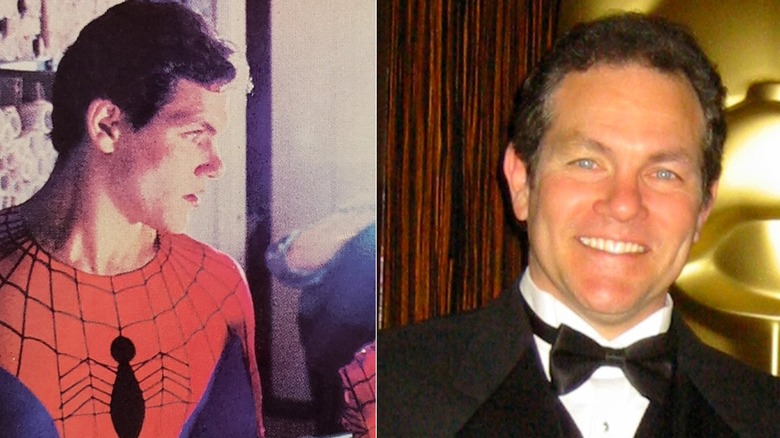Spider-Man: What Happened To Every Pre-1990s Actor?
If there's anything that the various Spider-Man movies throughout the 21st century have taught us, it's that across the Marvel multiverse, various versions of the comic book company's flagship superhero exist. "Spider-Man: No Way Home," "Spider-Man: Into The Spider-Verse," and "Spider-Man: Across The Spider-Verse" have leaned into that concept heavily, giving us glimpses of characters who, despite looking and acting vastly different from one another, are undeniably Spider-Man in their own way. "No Way Home," in particular, delivered a thrilling experience to three generations of cinematic Spider-fans by uniting the three actors who have portrayed Peter Parker in their respective live-action film franchises: Tobey Maguire, Andrew Garfield, and Tom Holland. But this famous trio are but a few of those who have portrayed our friendly neighborhood Spider-Man.
Indeed, we live in a time where there's no shortage of answers to the question, "Who's your favorite Spider-Man actor?" Aside from the aforementioned MCU Spider-trio, there have been numerous portrayals of the amazing superhero across different media, including cartoon shows, animated movies, and even video games. With that said, before the 1990s rolled in, there were only a handful of actors who had the opportunity to lend their vocal — and in even fewer cases, live-action — talents to the spider-themed superhero and breathe life into his sprawling mythos.
From the perpetually silent web-slinger who helped kids learn how to read to the peculiar, alien-powered mech pilot with a penchant for dramatic poses, here's a look at the different pre-'90s adaptations of Spider-Man — and how the actors who put their unique spin on him are doing today.
Paul Soles
In 1967, just five years after his debut in "Amazing Fantasy" Vol. 1 #15, Spider-Man thwipped his way from the comic book page to the small screen for the first time. The great responsibility of giving the world an idea of what Peter Parker sounds like fell upon the shoulders (and vocal cords) of experienced TV and voice actor Paul Soles. Soles played the role throughout the cartoon's 52-episode run, from 1967 to 1970. In an interview with SuperHeroHype, Soles shared that the gig went to him after the show's producers selected him from a pool of voice actors.
Over the course of seven decades, Soles had a colorful career doing voice work and acting in the United States and Canada, particularly in radio and theater. His acting prowess won him recognition at the 2001 Genies and the 2017 Canadian Screen Awards. On the comic-booky side of things, he voiced other Marvel characters (including Bruce Banner and Hawkeye) and even appeared in the 2008 "Hulk" movie. Soles' last documented TV acting job was for a 2021 episode of "Extroverted."
Soles may not have been able to spin webs like Spider-Man, but his life was no less filled with thrills. A pilot who was passionate about "sports cars, music, and flying," he frequented clubs and befriended many jazz musicians, regularly volunteered for the Canadian International Air Show, and even owned two trainer planes from the Royal Canadian Air Force. Sadly, he passed away on May 26, 2021.
Donald F. Glut
In the early days of Spider-Man's popularity, adaptations of his story were rare. Perhaps that's why Donald F. Glut decided to bring his vision of the wallcrawler to life himself. In 1969, Glut directed a fan film starring the web-slinger; he also played the titular character. Many say that this was the first Spider-Man fan film ever made — and, technically, the first instance of the Marvel superhero ever being portrayed in live-action. In an interview published by Spider-Friends.com, Glut revealed that three years before the debut of his fan movie, he told Spider-Man co-creator Stan Lee about his plans, and even showed the legendary scribe his costume. This also made him realize how little he understood about the industry at the time: "I'd had the naïve idea that I could get — for free — the rights to film a Spider-Man TV pilot. Stan graciously explained to me how that was impossible."
Over the years, Glut built an impressive resume as a screenwriter, magazine editor, book author, musician, and director. In an interesting twist, he also wrote some episodes of the 1981 cartoon "Spider-Man and His Amazing Friends." Nowadays, he still writes for comics, appears at conventions, and does volunteer work preparing dinosaur fossils for the Natural History Museum of Los Angeles County. Curiously, he did not like the 1970s live-action Spider-Man show. In a 2010 interview (via Straight 2 DVD), he had less-than-pleasant things to say about it: "I watched it and it looked pretty cheap to me."
Danny Seagren
The distinction of being the first officially licensed live-action adaptation of Spider-Man for television goes to Danny Seagren's take on the Marvel superhero. From 1974 to 1977, Seagren donned the classic red and blues for "The Electric Company," a children's program produced by the same team behind "Sesame Street." Curiously, Seagren's portrayal of Spider-Man does not speak; instead, his dialogue is written out, so that young viewers could learn how to read. "I was a faceless, silent mime," shared Seagren in a 2021 interview with 13th Dimension. "They could put another body in the costume if they got mad at me." Fortunately for Seagren, his role as the web-slinger was fixed until the show's demise.
According to Seagren, being Spider-Man had no impact on his career, as most folks didn't know who was behind the mask. However, fans who grew up watching him eventually start tracking him down and inviting him to guest at comic book conventions. Seagren also made appearances as Spider-Man at mall shows, with permission from Marvel. During such gigs, he wore his own costume, which he commissioned the show's prop-maker to make for him for $300 (over $1,800 in today's money). After "The Electric Company" ended, Seagren moved on to "Captain Kangaroo" as a puppet designer and voice actor. He continued working as a Muppet performer and designer until 1996.
These days, he no longer does puppeteering work, per his podcast interview with Comic Book Central. But he still does convention appearances — with his Spidey suit in tow.
Joe Ellison and Richard Eberhardt
The 1975 fan film "Spider-Man Versus Kraven the Hunter" is perhaps one of the most infamous pieces of "lost media" — videos, audio, or images that were known to exist, but are now inaccessible to the public — in Spider-Man history. This is mainly because it was the first Spider-Man fan film to explicitly get support (though not distribution rights) from Stan Lee himself, as confirmed in a 1970s issue of Marvel's FOOM fan magazine. Sadly, director Bruce Cardozo was reportedly against releasing his fan film to the public, and only showed it at conventions.
The role of Peter Parker went to Joe Ellison, who was reportedly praised by Marvel employees (including Lee and writer Roy Thomas) as a "dead ringer" for Spider-Man's civilian alter-ego. Curiously, Ellison seems to have pursued a different career path, as his portrayal of Peter Parker remains his only documented film credit. Meanwhile, Richard Eberhardt, who was part of the graphics team, portrayed Spider-Man in the suit. According to his IMDB page, Eberhardt continued working in the industry as a cinematographer and visual effects specialist, and was part of other superhero-themed productions like 1987's "Superman IV: The Quest for Peace" and 2004's "The Punisher." He also worked with Cardozo on a documentary released in 2016, "The Lost City of Cecil B. DeMille," for which they both served as associate producers.
Nicholas Hammond and Fred Waugh
From 1977 to 1979, Nicholas Hammond starred in the TV show "The Amazing Spider-Man," with stunt coordinator Fred Waugh as his costumed double. Hammond would go on to star in three feature films, technically making Hammond the first cinematic Spider-Man (and with a film trilogy, too).
Hammond continued acting after the show concluded, appearing in a total of 90 movies and TV shows. He recently appeared in Quentin Tarantino's 2019 film "Once Upon a Time in Hollywood" and the 2022 web series "The Crew's Ship." In a 2021 interview with The Hollywood Reporter, Hammond lamented the fact that he wasn't invited to reprise his role in 2021's "Spider-Man: No Way Home." "I think it would have been huge fun," the former "Sound of Music" child star shared. "It would have been a kick in the pants to have the old guy there." He currently lives in Australia with his partner, Robyn Nevin.
As for Waugh, he continued to do stunt work until 2004. Throughout his career, he lent his skills to 90 productions, including 1997's "Batman and Robin" and 2003's "Bruce Almighty." In an interview with the Los Angeles Times, his son, director Scott Waugh, credited him for inventing both the 35-mm helmet camera and the Pogo Cam, the handheld precursor to today's lightweight cameras. He passed away on December 2, 2012.
Shinji Todo and Hirofumi Koga
As part of a three-year licensing agreement with Marvel Comics in the '70s, the Japanese entertainment company Toei produced a wildly different live-action "Spider-Man" show that borrowed the character's name and costume, but threw everything else out the window. The series (which is sometimes referred to as "Supaidaman") ran for 41 episodes from 1978 to 1979, and starred Shinji Todō and Hirofumi Koga as Takuya Yamashiro (not Peter Parker) and Spider-Man, respectively.
Todō, who also went by the name Kōsuke Kayama, enjoyed a long and successful career in the Japanese acting industry. His most noteworthy role post-"Spider-Man" was in the 1992 TV series "To Dear Ones," which he top-billed; his most recent credited work for Japanese TV was in 2018. Outside of his country, however, Todō never quite attained the height of popularity reached by other voice or live-action actors who brought the web-slinger to life. As for Koga, "Spider-Man" appears to be his last credited acting work. In 2020, both Todō and Koga were interviewed for the first episode of "Marvel 616" (a documentary series for the Disney+ streaming platform), which gave an in-depth look at the production of the Japanese "Spider-Man" show.
James Krieg
In 1980, an NYU film student named James Krieg directed and starred in a fan film called "Viva Spider-Man," which borrowed elements from episodes of the 1967 "Spider-Man" cartoon. Interestingly, his independent project became the bridge between him and a vibrant career in superhero animation. Eventually, a copy of "Viva Spider-Man" found its way to Fox Kids executive Sid Iwanter, who introduced Krieg to John Semper, the creative driving force behind the 1990s cartoon "Spider-Man: The Animated Series" (via FanFilmFollies). Krieg ended up writing six episodes of the show, and even had a minor character on the show named after him.
Now based in Los Angeles, California, Krieg has been working as a senior producer for Warner Bros. Animation from 2015 up to this writing. Over the course of more than two decades, Krieg has written for 58 shows featuring characters from numerous properties, including Marvel, Jurassic Park, Ghostbusters, Tom and Jerry, He-Man, Scooby-Doo, and Ben 10. He is also credited as the producer for 43 shows, many of which feature Batman and other DC superheroes. His work has been nominated thrice for the Emmy Awards, as well as a Writers Guild Award, an Edgar Award from the Mystery Writers of America, and an Annie Award from the International Animated Film Association.
Ted Schwartz
The year 1981 was an oddity in Spider-Man animated history, as it featured not one, but two animated series starring the web-slinger, running side by side. One of the cartoons, simply titled "Spider-Man," highlighted the superhero's solo adventures. The series ran for 26 episodes, and starred Theodore "Ted" Schwartz (who had previously acted in a number of TV series) as both Peter Parker and Spider-Man.
There is very little verifiable information about Schwartz available on the internet. An article published by the Chicago Tribune, prior to his Spider-Man gig, revolved around Schwartz's portrayal of the titular character in the Broadway play "Lenny." It described the Brooklyn-born actor as a person who "avoids the limelight, writes screenplays and plays when he can, portrays his ex-idol, and pays bills by being one of the most widely used 'voice men' in the field of commercials."
After his work on "Spider-Man," Schwartz also lent his voice to other characters in TV shows such as 1985's "CBS Storybreak" and 1986's "The Transformers," as well as in the 1986 TV movie "GI Joe: Arise, Serpentor, Arise!" In the 1990s, he remained active in the theater industry, directing plays such as "The Deal" (via the Los Angeles Times) and "Belmont Avenue Social Club," in which he also played one of the leads (via Playbill). Sadly, the Spring 2016 issue of the SAG-AFTRA newspaper confirmed that Schwartz passed away on September 4, 2014.
Dan Gilvezan
"Spider-Man and His Amazing Friends" was a completely different show from "Spider-Man," despite the fact that they featured the same main character, had the same general aesthetic, and both debuted in 1981. "Spider-Man and His Amazing Friends" starred Dan Gilvezan, a Missouri-born theater actor who moved to Los Angeles. His portrayal of Spider-Man was among his first voice-acting gigs. Interestingly, he also became the on-camera spokesman for Jack in the Box at around the same time, a three-year run that opened voice-over opportunities for him in TV and radio advertising.
Since then, he has acted and voice-acted in over 100 animated series, live-action TV shows, movies, commercials, and even video games. He has lent his voice to other iconic pop culture characters as well. He provided the voice of Colossus in 1989's "Pryde of the X-Men," while old-school fans of the Transformers franchise know him best as the movie and video game voice of G1 Bumblebee (he even wrote a book about it). His most recent credited TV appearance was in an episode of 2021's "The Morning Show."
Interestingly, he made a comeback of sorts to the Spider-Man franchise when he voiced Miguel O'Hara, aka Spider-Man 2099, in the 2010 video game "Spider-Man: Shattered Dimensions." Currently residing in LA with his wife and daughter, Gilvezan continues to appear at various fan expos and pop culture conventions.
Scott Leva
Anyone who owns a copy of "Amazing Spider-Man" Vol. 1 #262 will certainly recognize Scott Leva. Leva, who worked as a stuntman in Hollywood, appeared on the cover of the issue as an unmasked Spider-Man. At around the same time, Leva was heavily featured in promotional material for Cannon Films' "Spider-Man" movie, which did not pan out well. While many speculated that he had already been officially cast, the project was actually canned before it could even find its Spidey (via Comic Book Legends Revealed).
To date, Leva has been credited as a stuntman, stunt coordinator, and actor in more than 200 productions. Aside from appearing at Marvel events and on comic book photo covers as the wallcrawler, Leva did have an opportunity to play the web-slinger on camera, in a manner of speaking: In a sequence for the blooper reel of 2000's "X-Men," Leva (a stunt coordinator for the film) unexpectedly pops up in full Spidey garb during a serious scene, causing everyone to burst into laughter.
For nearly three decades, Leva has been running his own stunt coordinator and equipment company, Precision Stunt Safety Specialists. Following the stunt-related death of a close colleague in 1997, Leva developed an original airbag design with enhanced safety features that prevent performers from bouncing or sliding out of the bag if they fell on it off-center or at an odd angle. This won Leva an Academy Award for Technical Achievement in 2006, as well as a Primetime Emmy Engineering Award in 2008.
